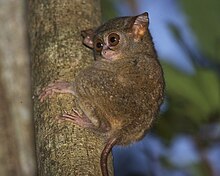Tangkoko Nature Reserve is in Northern Sulawesi (Sulawesi Utara), on the north-eastern tip of Sulawesi island of Indonesia.
Understand
[edit]
History
[edit]The first conservation area at Mount Tongkoko was established in 1919. To this, the Duasaudara area has been added in 1978, and the Batuangus and Batuputih areas in 1981, together encompassing a total of 8,718 hectares (21,540 acres). Visitation is only allowed in the Batuputih area.
Landscape
[edit]Flora and fauna
[edit]
Located at the foot of Dua Saudara Mountain, the area is comprised of rolling hills and valleys with a variety of hardwood trees and unusual plant life.
The animal life is also quite varied, and one can often view Tarsius tarsier (the world's smallest primate), black tailless monkeys, maleo birds, wild pigs, and kuskus (marsupials). Tangkoko Batuangus Reserve offers a suitable protective environment to help prevent these animals from becoming extinct. A local tour operator can provide an experienced guide who can assist in spotting the wildlife.
Climate
[edit]Responsible tourism
[edit]If you are here, you are most probably looking for the Tarsier. Remember that they are a nocturnal animals, they are active at night, and therefore they are very sensitive to light. Do not use your torchlight on the animals (the guides will do it for you), and do not use your flash when you are photographing them (or other animals). If your equipment is unable to take a good quality photo without flash, flash is not going to help much to make great photos, but it will be a great annoyance for the animals.
There's no system in place to regulate the guides. Some of them do not follow the Park rules (e.g. using too many torchlight, directing the torchlight directly to the animals' eyes, feeding them, waking the nocturnal animals in the afternoon). Reprimand such guides, and do not give them tips on top of the agreed guide rates.
Get in
[edit]Tangkoko National Park is about 50 kilometres (31 miles) from Manado, in the northern sector of Bitung. It takes 1 to 2 hours to reach from Bitung or Manado.
You can hire a private car or a private tour to reach the place; or by taking a public transport Angkot, from 'Paal2 Terminal' in Manado towards Bitung (Rp 10,000), ask the driver to drop you off along the way towards 'Batu Putih' or Tangkoko, and then transfer to an open aired pick-up truck (also Rp 10,000).
Fees and permits
[edit]Entrance fee to the Tangkoko Nature Park is Rp 100,000 per person for foreign tourists, and Rp 5,000 for locals.
Guides and Rangers charge Rp 100,000 to 200,000 per person (note: not per group) for a hike through and around the Nature Reserve, depending on the trip type (morning or afternoon), and day of the week (Sunday is typically more expensive).
Get around
[edit]See
[edit]- There is a tiny village nearby that you can walk to for a while.
- Black beach just beside the village.
Do
[edit]The tarsiers are the top attraction, but they don't come down from the trees until dusk; so you need your dive lights for the hour walk out of the woods.
Spending an overnight is also worth doing.
- Day 1: (13:00-14:00) Transfer by Safari Tours bus or AC 4 pax vehicle to Nature Reserve. The 2 hour drive to the 9,000 hectares (22,000 acres) national park is quite scenic as we pass through small villages. Upon arrival, immediately check in to a homestay. You will then be guided by local forest rangers (and Safari staff) in search of the Black Crested Macaque (Black Monkey indigenous to North Sulawesi), hornbills, and couscous, as well as other fauna specific to the reserve. Depending on what time it gets dark, you will head into the denser part of the jungle as the sun is setting, where you will (most likely) be able to get photographs of the Tarsius Tarsier (the world's smallest primate). After it is completely dark and the Tarsier have departed for their nightly foraging, you head back to the homestay for a basic traditional dinner.
- Day 2: Rising early, you will again hike into the forest with local rangers, where you will have the best opportunity to view more birds, and certainly the Black Crested Macaque as these monkeys are earlier risers and are searching out food along the coastline at Tangkoko. After several hours, it's back to the homestay for a traditional breakfast, and prepare to go back to Manado or Bitung. Arrive in Manado between 09:00-11:00.
Buy
[edit]Eat
[edit]Eating options are a bit limited in this place, and the price is more expensive than Manado. Usually, overnight guests stick to their accommodation.
Drink
[edit]Sleep
[edit]Losmen (simple guesthouses) are available for overnight stays.
Lodging
[edit]Camping
[edit]Backcountry
[edit]Connect
[edit]Broadband internet has not reached this area yet. Only Telkomsel network is running, and the internet is unstable and slow. Guest houses are offering Wi-Fi from their mobile phone hotspot.
Stay safe
[edit]Go next
[edit]Getting out is a bit tricky. Either you hop on the public transport the same way you go in, or get an accommodation to arrange transportation to Manado, Bitung, or the airport.

